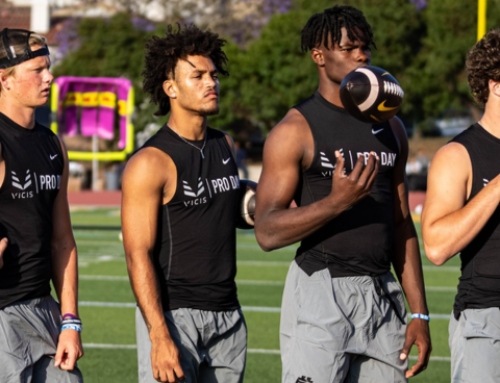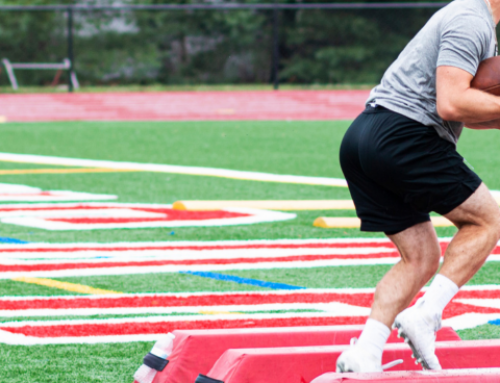Why the 40-Yard Dash Is Overrated as a Test for Running Backs
At the 2017 NFL Combine, fast approaching, the top pro football prospects in America will showcase their athleticism with a battery of tests inside Lucas Oil Stadium in Indianapolis.
According to WalterFootball.com, the top 3 draft-eligible RBs are Leonard Fournette, Dalvin Cook and Christian McCaffrey. These athletes have projected 40-Yard Dash times ranging from 4.49 to 4.52; and many fans, scouts and media pundits may express disappointment if the three athletes fail to meet or exceed those projected time (for examples of this, check out the articles here and here).
However, the performance metrics below tell us that their negativity may be much ado about nothing.
As we take a look back at the running back performances from the 2016 season, one thing that stands out is that 3 of the top 4 and 8 of the top 12 “big play” RBs (defined as breaking runs of 10+ yards) ran 40-Yard Dash times of 4.57 or slower.
- Elliott – 4.47 (NFL Combine), 48 big plays on 322 carries
- Howard – 4.59 (hand-timed at Pro Day), 43 big plays on 252 carries
- Ajayi – 4.57 (NFL Combine), 39 big plays on 260 carries
- Bell – 4.60 (NFL Combine), 37 big plays on 261 carries
- McCoy 4.50 (hand-timed at Pro Day), 34 big plays on 234 carries
- D. Johnson – 4.50 (NFL Combine), 34 big plays on 293 carries
- D. Murray – 4.43 (NFL Combine), 32 big plays on 293 carries
- Freeman – 4.58 (NFL Combine), 30 big plays on 227 carries
- Blount – 4.74 (NFL Combine), 29 big plays on 299 carries
- Hyde – 4.66 (NFL Combine), 26 big plays on 217 carries
- Crowell – 4.57 (NFL Combine), 26 big plays on 198 carries
- Ingram – 4.66 (NFL Combine), 25 big plays on 205 carries
Note: To equate hand-held Pro Day times to the electronically timed numbers of the NFL Combine, one can assume the the latter number would be .175 slower, according to the information in this article with information provided by Zybek Sports
Another thing to consider when weighing the importance of the 40-Yard Dash for running backs is the rarity of game opportunities when a player can run 40 yards in a relatively straight direction. When we narrow the definition of “big plays” to touchdown runs of 50+ yards, looking at the all-time records for this parameter, we see some surprising numbers that expose how uncommon it really is. Here are the NFL running backs with the most career touchdown runs over 50 yards (based on stats through 2016).
- Barry Sanders – 15, averaged one 50-plus-yard TD every 204 carries.
- Adrian Peterson – 14, averaged one 50-plus-yard TD every 172 carries
- Jim Brown – 12, averaged one 50-plus-yard TD every 197 carries
- Chris Johnson (the fastest athlete in the history of the NFL Combine) – 12, averaged one 50-plus-yard TD run for every 178 carries.
These great backs made approximately 1 to 1.5 touchdown runs of 50-plus yards per season. The next time you see a running back prospect being bashed for a perceived lack of speed, keep these numbers in mind for context on the role of “breakaway speed,” as measured by the 40-Yard Dash, in achieving success as an NFL running back. Bottom line: not much at all.
READ MORE:
[cf]skyword_tracking_tag[/cf]RECOMMENDED FOR YOU
MOST POPULAR
Why the 40-Yard Dash Is Overrated as a Test for Running Backs
At the 2017 NFL Combine, fast approaching, the top pro football prospects in America will showcase their athleticism with a battery of tests inside Lucas Oil Stadium in Indianapolis.
According to WalterFootball.com, the top 3 draft-eligible RBs are Leonard Fournette, Dalvin Cook and Christian McCaffrey. These athletes have projected 40-Yard Dash times ranging from 4.49 to 4.52; and many fans, scouts and media pundits may express disappointment if the three athletes fail to meet or exceed those projected time (for examples of this, check out the articles here and here).
However, the performance metrics below tell us that their negativity may be much ado about nothing.
As we take a look back at the running back performances from the 2016 season, one thing that stands out is that 3 of the top 4 and 8 of the top 12 “big play” RBs (defined as breaking runs of 10+ yards) ran 40-Yard Dash times of 4.57 or slower.
- Elliott – 4.47 (NFL Combine), 48 big plays on 322 carries
- Howard – 4.59 (hand-timed at Pro Day), 43 big plays on 252 carries
- Ajayi – 4.57 (NFL Combine), 39 big plays on 260 carries
- Bell – 4.60 (NFL Combine), 37 big plays on 261 carries
- McCoy 4.50 (hand-timed at Pro Day), 34 big plays on 234 carries
- D. Johnson – 4.50 (NFL Combine), 34 big plays on 293 carries
- D. Murray – 4.43 (NFL Combine), 32 big plays on 293 carries
- Freeman – 4.58 (NFL Combine), 30 big plays on 227 carries
- Blount – 4.74 (NFL Combine), 29 big plays on 299 carries
- Hyde – 4.66 (NFL Combine), 26 big plays on 217 carries
- Crowell – 4.57 (NFL Combine), 26 big plays on 198 carries
- Ingram – 4.66 (NFL Combine), 25 big plays on 205 carries
Note: To equate hand-held Pro Day times to the electronically timed numbers of the NFL Combine, one can assume the the latter number would be .175 slower, according to the information in this article with information provided by Zybek Sports
Another thing to consider when weighing the importance of the 40-Yard Dash for running backs is the rarity of game opportunities when a player can run 40 yards in a relatively straight direction. When we narrow the definition of “big plays” to touchdown runs of 50+ yards, looking at the all-time records for this parameter, we see some surprising numbers that expose how uncommon it really is. Here are the NFL running backs with the most career touchdown runs over 50 yards (based on stats through 2016).
- Barry Sanders – 15, averaged one 50-plus-yard TD every 204 carries.
- Adrian Peterson – 14, averaged one 50-plus-yard TD every 172 carries
- Jim Brown – 12, averaged one 50-plus-yard TD every 197 carries
- Chris Johnson (the fastest athlete in the history of the NFL Combine) – 12, averaged one 50-plus-yard TD run for every 178 carries.
These great backs made approximately 1 to 1.5 touchdown runs of 50-plus yards per season. The next time you see a running back prospect being bashed for a perceived lack of speed, keep these numbers in mind for context on the role of “breakaway speed,” as measured by the 40-Yard Dash, in achieving success as an NFL running back. Bottom line: not much at all.
READ MORE:
[cf]skyword_tracking_tag[/cf]









